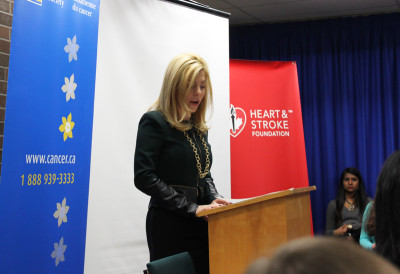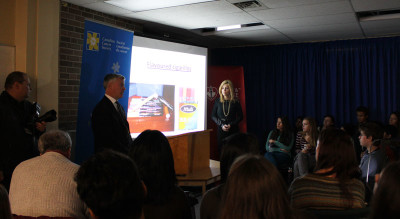War on tobacco hits White Oaks Secondary School
STORY AND PHOTOS BY ADAM BUCK
The federal government held an anti-smoking seminar at White Oaks Secondary School last week as a part of its “war on tobacco” campaign.
MP Eve Adams, parliamentary secretary to the minister of health, lead the presentation and open discussion on tobacco use among youth. With her was Rob Cunningham, senior policy analyst with the Canadian Cancer Society and author of Smoke and Mirrors: The Canadian Tobacco War.
“This is definitely important,” said Alex Moroz, a White Oaks student council member. “Getting a number of students from around the school, trying to get the message out – it’s a great initiative they’re taking.”
She says White Oaks was represented well, with a variety of attendees who enjoyed having a voice.

MP Eve Adams speaking to White Oaks students about the importance and results of anti-smoking initiatives by the federal government.
Cunningham and Adams listened to students share personal experiences and ideas on how to keep people off nicotine. The two also provided info about tobacco use, the resulting health effects and what has been done to try to reduce the number of smokers in Canada.
“One of the very good things the government has done is to improve the warnings on packages,” said Cunningham. “We have among the largest warnings in the world.”
Adams pointed out what she sees as accomplishments for her government.
“Smoking amongst Canadian students is at an all-time low,” she said. “Only seven per cent of youth ages 15 to 17 are smoking. That means our work is actually working.”
“We’ve also prohibited sale of cigarettes, little cigars and blunt wraps that contain flavours,” added Adams, explaining such products specifically target youth.
Other tactics mentioned were cracking down on crimes such as smuggling and contraband tobacco, the Quit4Life program and further restrictions on advertising tobacco products in publications read by youth.
“The overwhelming majority of smokers began as teenagers,” said Cunningham. “So it’s important that we prevent teens from starting.
“We’ve made progress,” he added, “but we have a lot more work to do. It’s good to hear new ideas to move things forward.”
He stated the best strategy involves multiple components.
White Oaks’ principal John Stieva says the youth have a large responsibility in the issue. “There are more non-smokers than smokers,” he said, “so we’re hoping the reverse peer pressure will have an impact.”
He also referred to the financial strain on both the healthcare system and the individual, saying for every pack of cigarettes, a smoker’s hourly wage is “literally going up in smoke.”
Adams was impressed with her first conference of this nature.
“I think it was a very successful discussion,” she said. “The students here at White Oaks were very forthcoming. They were quick to share personal stories of how smoking has affected them.”
Cunningham is determined to see the campaign continue, saying “we just have to keep at it.”





